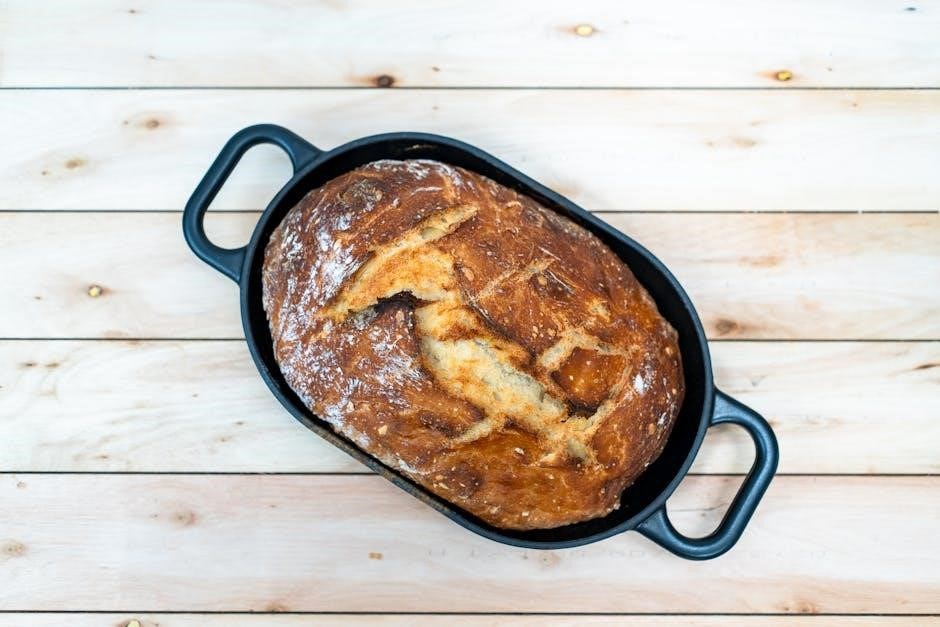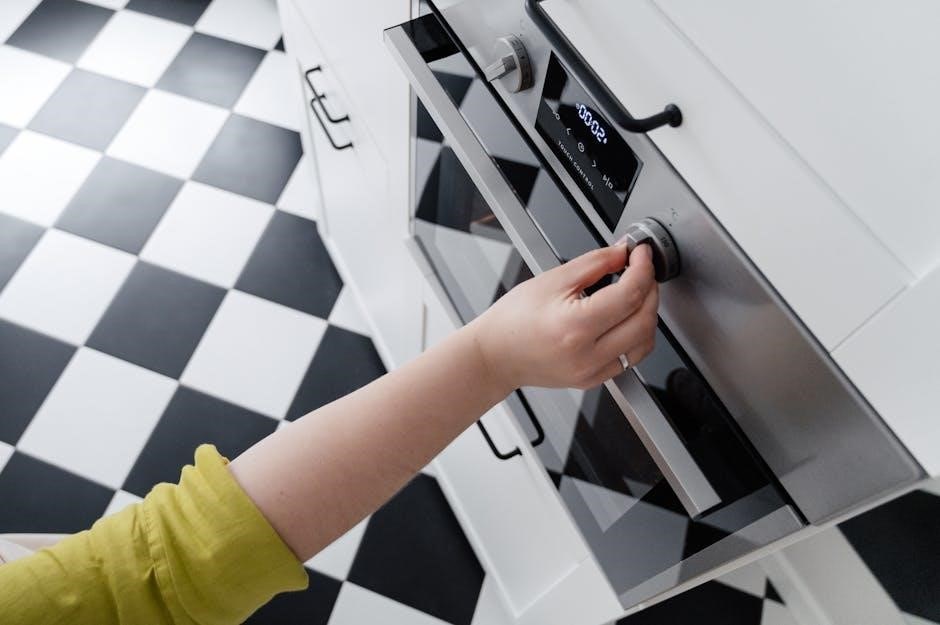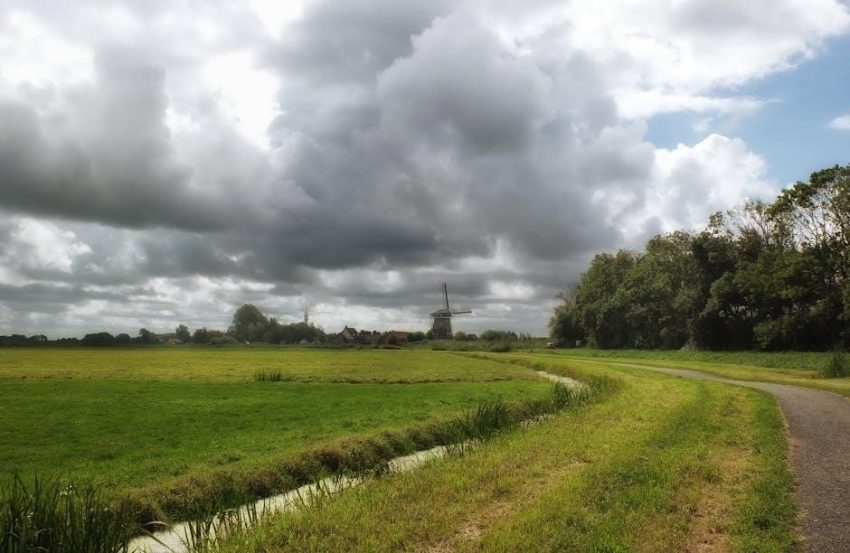Welcome to the Dutch Oven Temperature Guide, your ultimate resource for mastering heat control in cast iron cooking. Discover how precise temperatures ensure perfect results, whether searing, roasting, or baking, and learn how materials like Lodge and Le Creuset perform. This guide covers optimal settings for various dishes, helping you achieve culinary success every time.
Understanding the Basics of Dutch Oven Cooking
Dutch oven cooking relies on understanding heat distribution and retention. Preheating is crucial for even cooking, as cast iron retains heat well. The thickness of the Dutch oven material impacts temperature consistency. Cast iron Dutch ovens are durable and versatile, suitable for simmering, roasting, and baking. Proper preheating ensures food cooks evenly, while the heavy lid traps moisture and heat, enhancing flavor. This foundational knowledge is key to mastering Dutch oven techniques.

Why Temperature Control Matters in Dutch Oven Cooking
Temperature control ensures even cooking, prevents hotspots, and achieves desired results. Monitoring heat is crucial for consistent, high-quality Dutch oven cooking outcomes.
The Impact of Heat Distribution on Cooking Results
Even heat distribution is vital for consistent Dutch oven cooking. Uneven heat can lead to hotspots, undercooked areas, or burnt edges. Proper temperature control ensures uniform cooking, preventing such issues. Materials like cast iron naturally retain and distribute heat well, but factors like lid placement and preheating also play a role. Achieving even heat guarantees better texture, flavor, and overall dish quality, making it a cornerstone of successful Dutch oven cooking.
Basic Temperature Ranges for Dutch Oven Cooking
Dutch oven cooking operates within three key temperature ranges: low (200-300°F) for simmering and stewing, medium (300-400°F) for roasting and baking, and high (400-500°F) for searing and browning. Understanding these ranges is essential for achieving the desired cooking results.
Low Heat (200-300°F) for Simmering and Stewing
Low heat (200-300°F) is ideal for simmering and stewing, allowing gentle cooking that tenderizes tougher cuts of meat and infuses flavors. This range prevents rapid boiling, ensuring even cooking. It’s perfect for dishes like chili, stews, and braises. To maintain consistent heat, use a thermometer and adjust coals or stove heat as needed. Lid placement helps retain moisture, enhancing the richness of slow-cooked meals.
Medium Heat (300-400°F) for Roasting and Baking
Medium heat (300-400°F) is perfect for roasting and baking, offering a balanced cooking environment that promotes even browning and moisture retention. This range is ideal for dishes like roasted meats, casseroles, and breads. Achieving consistent heat is key; use thermometers or adjust coals/stove heat as needed. Lid placement helps distribute heat evenly, ensuring flavorful results. This temperature range is versatile, accommodating both hearty roasts and delicate baked goods.
High Heat (400-500°F) for Searing and Browning
High heat (400-500°F) is essential for searing and browning, creating a crispy crust on meats and vegetables. Preheat your Dutch oven with oil to prevent sticking. Use thermometers to monitor temperature, adjusting heat sources like charcoal or stoves as needed. Proper ventilation, such as slightly lifting the lid, helps control intensity. This range is ideal for achieving caramelized flavors quickly, but beware of overheating, which can burn food. Precision is key for perfect results.
Factors Affecting Temperature in a Dutch Oven
Material, thickness, and heat source significantly impact temperature control. Charcoal, wood, or stoves vary in heat consistency, while lid placement and ventilation also influence internal temperatures and cooking results.
Material and Thickness of the Dutch Oven
The Dutch oven’s material and thickness greatly influence heat retention and distribution. Thicker, heavy-duty ovens retain heat longer, while thinner ones heat up faster. Cast iron is the most common material due to its excellent heat retention. Enameled cast iron offers added durability and rust resistance. The choice of material and thickness affects cooking performance, with thicker ovens generally providing more consistent results. This makes them ideal for low-and-slow cooking methods like stewing and braising.
Heat Source and Fuel Type (Charcoal vs. Wood vs. Stove)
The heat source significantly impacts Dutch oven performance. Charcoal offers consistent heat and is ideal for outdoor cooking, while wood provides a unique smoky flavor but can be harder to control. Stovetop and oven heating allow precise temperature management, making them suitable for indoor use. Each fuel type has its advantages, with charcoal being the most traditional and versatile for achieving desired cooking results in various settings.
Lid Placement and Ventilation
Lid placement and ventilation are crucial for controlling temperature and moisture in Dutch oven cooking. A properly seated lid retains heat and promotes even cooking, while slight gaps can release excess steam. For bread baking, leaving the lid slightly ajar helps achieve a crispy crust. Adjusting ventilation ensures optimal airflow, preventing hotspots and overcooking. Mastering lid placement is key to achieving consistent results in various recipes, from stews to roasted dishes.
How to Measure and Monitor Temperature Accurately
Accurate temperature measurement is essential for Dutch oven cooking. Use thermometers for precise control or estimate heat by observing coals and lid placement. Proper monitoring ensures even heat distribution and optimal results for searing, roasting, or baking. This guide provides expert tips for maintaining consistent temperatures.
Using Thermometers for Precise Temperature Control
Thermometers are essential for accurate Dutch oven temperature monitoring. Digital or oven-safe thermometers provide precise readings, ensuring ideal heat levels for roasting, baking, or searing. They eliminate guesswork, allowing consistent results. Whether using a Lodge or Le Creuset, thermometers help maintain perfect temperatures, crucial for achieving tender stews or crispy bread. Invest in a reliable thermometer to elevate your Dutch oven cooking and ensure dishes are cooked to perfection every time.
Estimating Heat Without a Thermometer
Estimating heat in a Dutch oven without a thermometer requires observation and experience.Listen for a gentle simmer (low heat) or a vigorous roar (high heat).Use the hand test: hover your hand 5 inches above the oven; if it feels too hot to hold, it’s high heat (400-500°F).For medium heat (300-400°F), you can hold your hand for 5-7 seconds. Adjust coals or ventilation to fine-tune the temperature for perfect cooking results;

Adjusting Temperature for Different Recipes
Adjusting temperature for different recipes involves tweaking charcoal, using heat diffusers, and monitoring cooking progress. Techniques like lid adjustment and oven rotation ensure even heat distribution for optimal results.
Temperature Conversion for Specific Dishes
Precise temperature control is crucial for achieving desired results in Dutch oven cooking. Use thermometers to monitor and adjust heat sources, ensuring accuracy. For example, bread baking requires 425°F, while stews thrive at 300°F. Always consider conversion between Fahrenheit and Celsius for recipe consistency. Adjust coals or stove settings to maintain optimal temperatures, and rotate the oven for even heat distribution. This ensures dishes like roasts and casseroles cook perfectly every time.
Compensating for Weather Conditions
Weather significantly impacts Dutch oven temperature control. In cold or windy conditions, increase heat by adding coals or adjusting placement. Use a windbreak to stabilize heat and prevent temperature fluctuations. In hot weather, reduce coals and increase ventilation to avoid overheating. Monitor temperature closely and adjust as needed to maintain consistency. Proper insulation and lid management also help compensate for external conditions, ensuring even cooking regardless of the environment.
Common Mistakes in Dutch Oven Temperature Management
Common mistakes include overheating from excessive coals and underheating due to insufficient fuel, both leading to uneven cooking results. Awareness and adjustments are key to success.
Overheating and Underheating: Signs and Solutions
Overheating can cause food to burn or cook unevenly, while underheating leads to raw or undercooked dishes. Signs of overheating include a too-rapid boil or excessive smoke. Solutions involve reducing heat by removing coals or adjusting ventilation. For underheating, increase heat by adding coals or improving airflow. Monitoring temperature with thermometers and adjusting fuel sources helps maintain ideal cooking conditions and prevents these common issues.

Optimal Temperature Settings for Popular Dutch Oven Dishes
Popular dishes like pot roast, chili, and cobblers thrive at 300-350°F, while bread baking often requires 425-450°F. Adjusting heat ensures even cooking and avoids overcooking.
Bread Baking and Roasting
Bread baking in a Dutch oven typically requires temperatures between 425-450°F for a crispy crust, while roasting meats or vegetables thrives at 300-400°F. Preheating the oven ensures even heat distribution, and using steam enhances bread’s rise. For roasts, maintaining consistent heat prevents overcooking. Always use a thermometer for accuracy, especially when baking bread, to achieve the perfect golden-brown finish and tender interior. Adjust heat as needed for optimal results.
Stews and Braises
For stews and braises, maintain a temperature of 200-300°F to ensure tender, flavorful results. Dutch ovens excel at slow cooking, with their thick walls retaining heat evenly. Use a thermometer for precision, or estimate by coal size and color. Liquid should cover at least half the ingredients to prevent drying. This low-and-slow method breaks down connective tissues, creating rich, hearty dishes perfect for comfort cooking. Adjust heat as needed to maintain a gentle simmer for optimal tenderness.

Tools and Accessories for Temperature Monitoring
Essential tools include thermometers for precise heat measurement, heat diffusers to distribute heat evenly, and lid lifters for safe ventilation control, ensuring consistent cooking temperatures in your Dutch oven.
Thermometers, Heat Diffusers, and Lid Lifters
Thermometers are essential for precise temperature monitoring, ensuring dishes cook evenly without overheating. Heat diffusers prevent hotspots by distributing heat uniformly, especially on stovetops. Lid lifters allow safe handling of heavy lids, minimizing burns and maintaining proper ventilation. These tools collectively enhance control and safety in Dutch oven cooking, making them indispensable for achieving consistent results in various recipes and cooking conditions.
Tips for Maintaining Consistent Temperature
Preheat your Dutch oven gradually, use insulation to retain heat, and stir gently to avoid disrupting heat distribution. Monitor lid placement to maintain steady temperatures during cooking.
Preheating, Insulation, and Stirring Techniques
Preheat your Dutch oven by placing it near the heat source for 10-15 minutes. Use insulation like coals or blankets to retain heat. Stir gently to avoid disrupting heat distribution. Consistent preheating ensures even cooking, while proper insulation maintains temperature. Stirring techniques should be gentle to prevent heat loss, especially when cooking delicate dishes. These steps help achieve consistent results in Dutch oven cooking.

